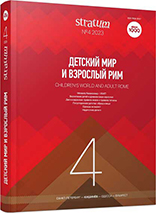Дети и детство у средневековых тюрок VI—VIII вв.
Children and Childhood among the Medieval Türks. 6th—8th Centuries
Author(s): Talgat ZhumaganbetovSubject(s): History, Archaeology, Social history, Family and social welfare, 6th to 12th Centuries
Published by: Издательский дом Stratum, Университет «Высшая антропологическая школа»
Keywords: birth; pastoral society; boy; girl; Kok Türks; Umai the Goddess; Tengri; eldes and yongers; patronymic relationship;
Summary/Abstract: Social relations are among the most complex matters in history of the Inner and Western Asia. Archaeological and narrative sources do not offer us a complete picture of daily life and intra-family relations. Written accounts focused on the warriors, campaigns and deeds of the rulers. However, episodic information and ethnographic data allow us to look into the world of children and childhood. Among the medieval Kok Türks, the relations among children in the same family are a model in the construction of the state. As in any patriarchal family, the relationship was based on obeying to the elders, i. e. the father and elder brothers. The elders take care of the general well-being of the family, protect the younger ones, and in return, the younger brothers and sisters obey them and their requirements. Among the Kok Türks, the dynastic clan “Ashina and Ashide” were recognized as “elder brothers”, while the people — “Budun” — became their “younger brother”. All this, together with religious ideas, ensured the stability of the society during the 200 years of the existence of the Khaganate and in subsequent successor states of the Kok Türks.
Journal: Stratum plus. Археология и культурная антропология
- Issue Year: 2023
- Issue No: 4
- Page Range: 101-111
- Page Count: 11
- Language: Russian

